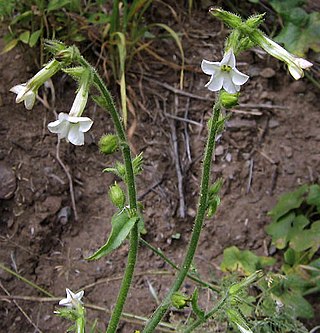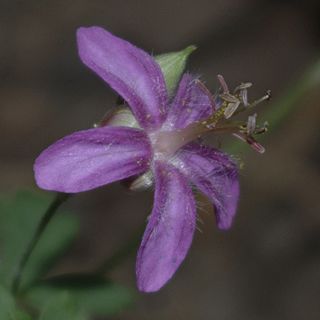
The Sonoran Desert is a desert in North America and ecoregion that covers the northwestern Mexican states of Sonora, Baja California, and Baja California Sur, as well as part of the southwestern United States. It is the hottest desert in both Mexico and the United States. It has an area of 260,000 square kilometers (100,000 sq mi).

Penstemon palmeri, known by the common name Palmer's penstemon, is a species of perennial flowering plant in the genus Penstemon that is notable for its showy, rounded flowers, and for being one of the few scented penstemons. The plant, in the family Plantaginaceae, is named after the botanist Edward Palmer.

Agave parryi, known as Parry's agave or mescal agave, is a flowering plant in the family Asparagaceae, subfamily Agavoideae. It is a slow-growing succulent perennial native to Arizona, New Mexico, and northern Mexico.

Nolina parryi is a flowering plant that is native to Baja California, southern California and Arizona.

Calycoseris parryi, the yellow tackstem, is a spring wildflower found in the Mojave Desert, the Sonoran Desert, and surrounding regions of the southwestern United States and northwestern Mexico. It is found in California, Nevada, Utah, Arizona, and Baja California.
Sphaeralcea incana, with the common names gray globemallow and soft globemallow, is a desert plant in the mallow family (Malvaceae).

Calliandra eriophylla, commonly known as fairy duster, is a low spreading shrub which is native to deserts and arid grasslands in California, Arizona, New Mexico, Texas, and Mexico.

Hibiscus denudatus is a perennial shrub of the mallow family, Malvaceae. It is in the rosemallow genus, Hibiscus.

Rafinesquia neomexicana is a species of flowering plant in the family Asteraceae. Common names include desert chicory, plumeseed, or New Mexico plumeseed. It has white showy flowers, milky sap, and weak, zigzag stems, that may grow up through other shrubs for support. It is an annual plant found in dry climate areas of the southwestern deserts of the US and northwestern deserts of Mexico.

Nicotiana clevelandii is a species of wild tobacco known by the common name Cleveland's tobacco.

Geranium caespitosum, the purple cluster geranium or pineywoods geranium, is a perennial herb native to the western United States and northern Mexico. Its US distribution includes Arizona, Colorado, Nevada, New Mexico, Texas, Utah, and Wyoming.

Primula parryi, or Parry's primrose, is a herbaceous perennial native to wet areas from the subalpine zone to alpine tundra in the Rocky Mountains from Montana to Arizona and New Mexico.

Ziziphus parryi is a species of flowering plant in the buckthorn family known by the common name Parry's jujube.

Flora of the Colorado Desert, located in Southern California. The Colorado Desert is a sub-region in the Sonoran Desert ecoregion of southwestern North America. It is also known as the Low Desert, in contrast to the higher elevation Mojave Desert or High Desert, to its north.
Flora of the Arizona Upland includes higher elevation Sonora Desert plants that require more moisture and cooler climates than those of the adjacent Sonoran Desert areas in the Colorado Desert of the lower Colorado River valley area, and which can withstand frost, unlike plants of the Sonoran Desert south of the border between the United States and Mexico.

Eriogonum abertianum, with the common names Abert's buckwheat and Abert wild buckwheat, is a species of buckwheats in the family Polygonaceae.
Desert beardtongue or desert penstemon is a common name for several plants and may refer to:

Bouteloua parryi, colloquially known as Parry's grama, is a grass species in the grama genus native to the southwestern United States and northern Mexico.
















